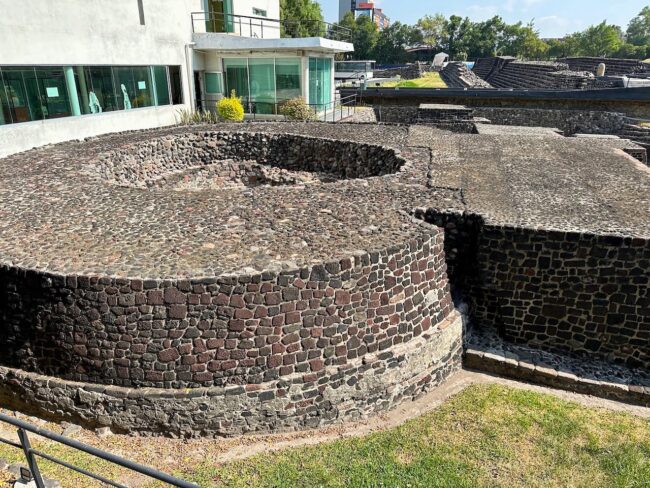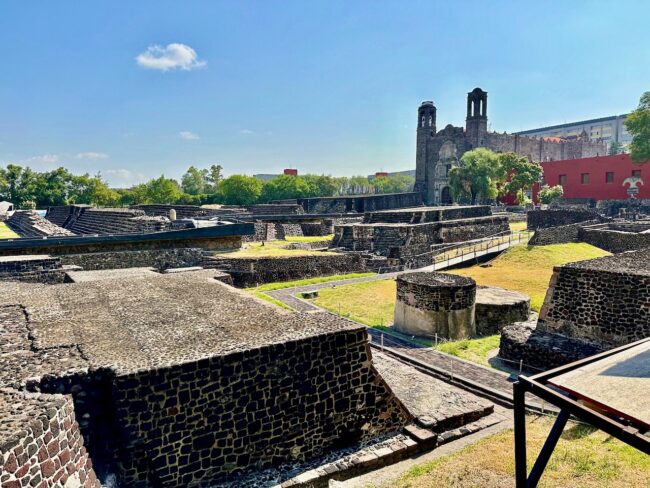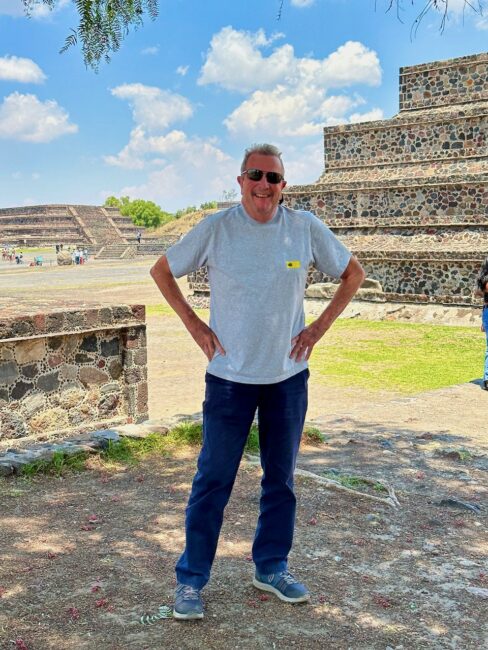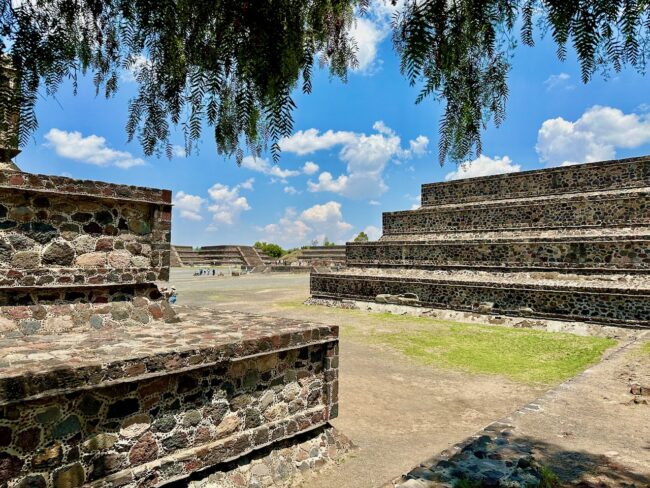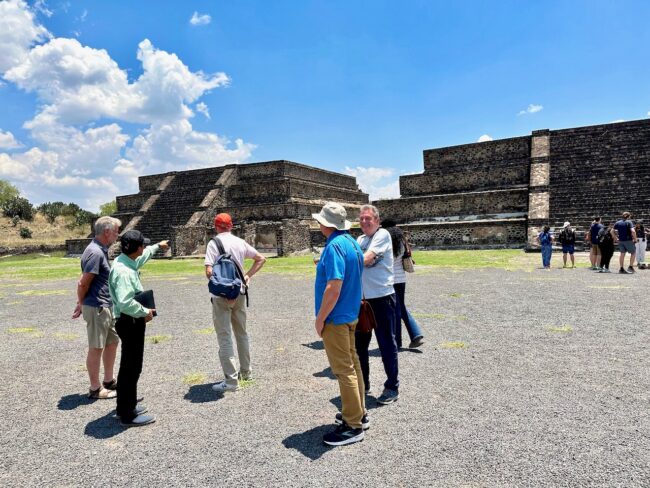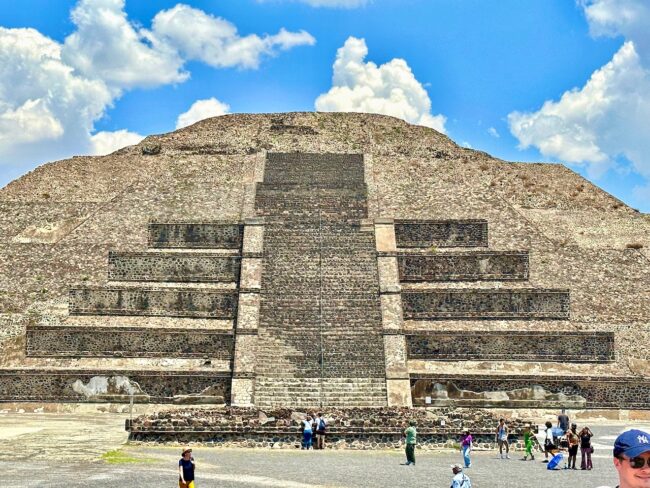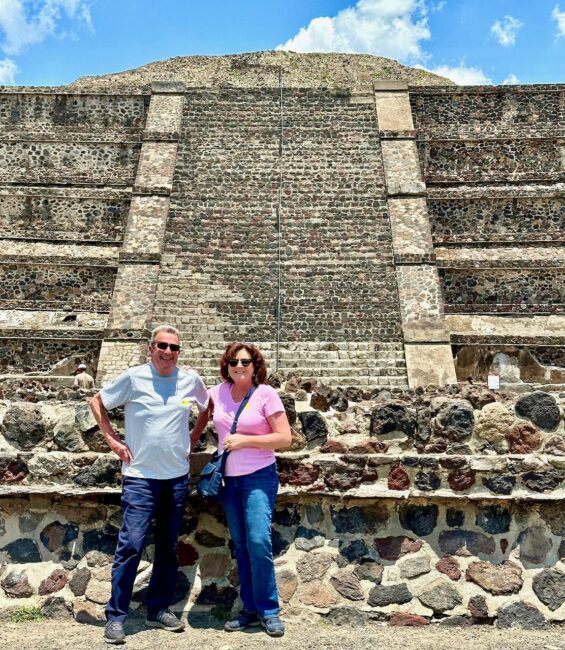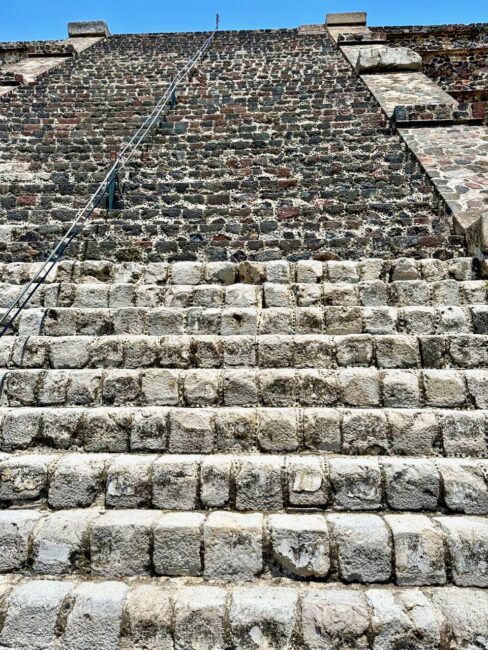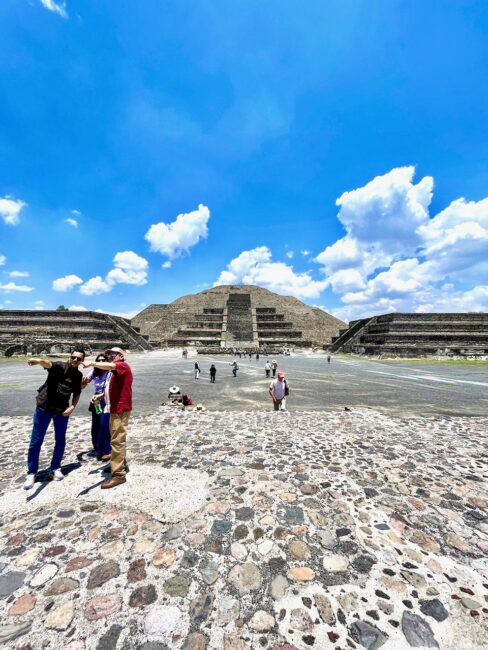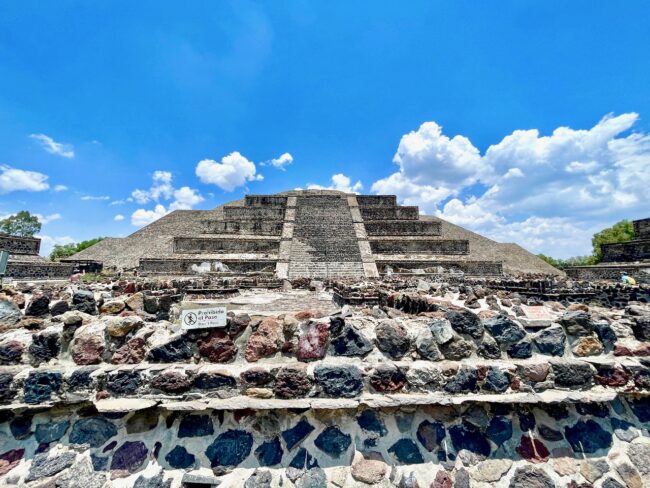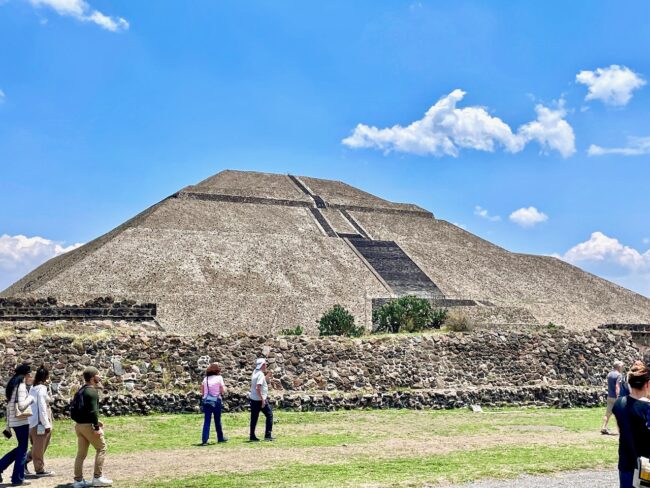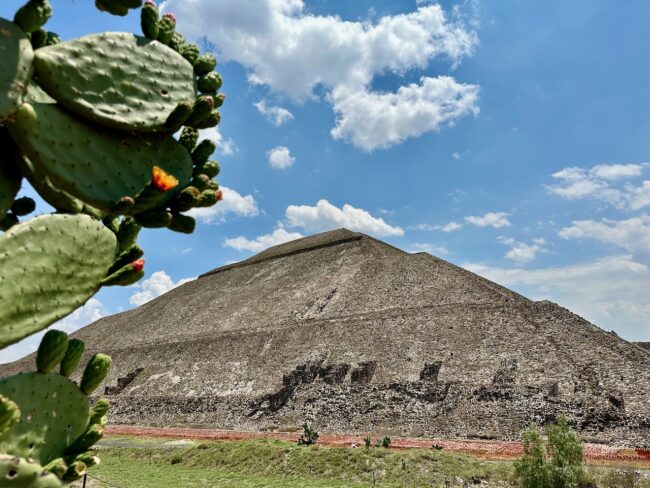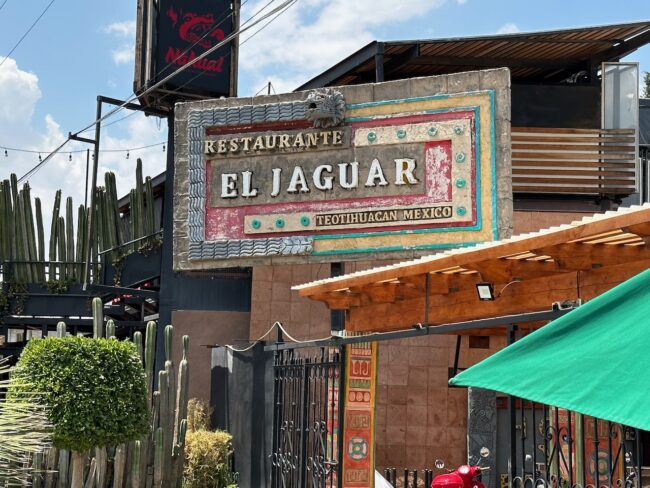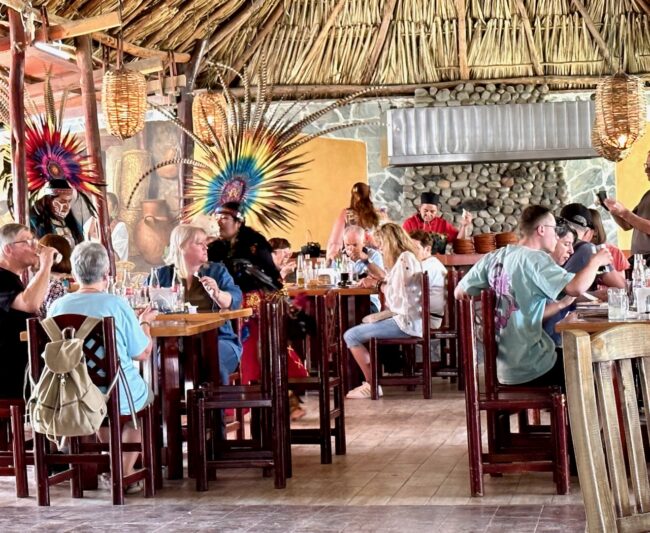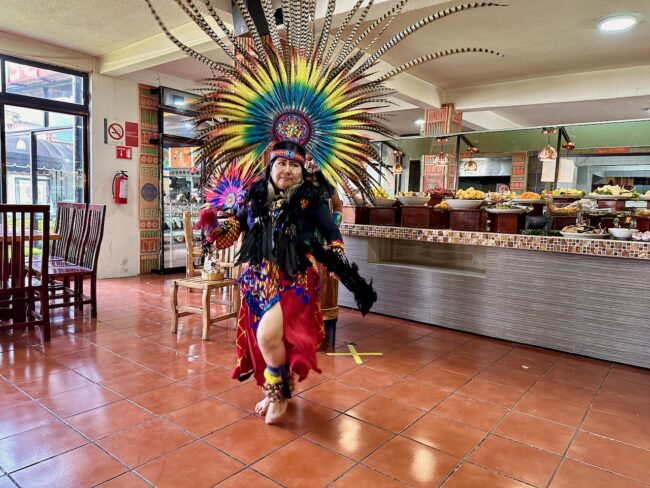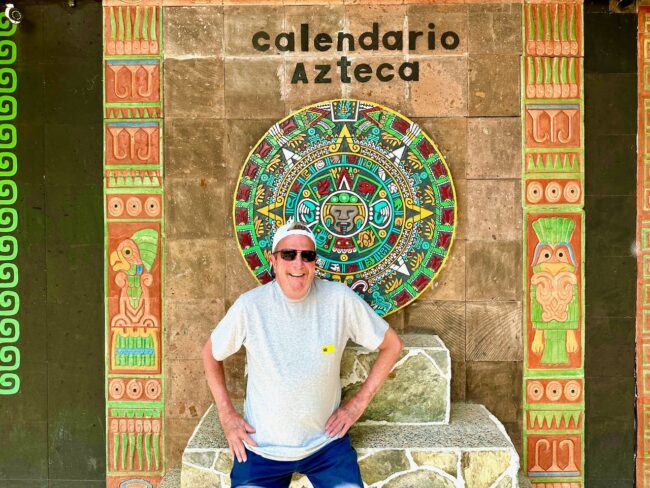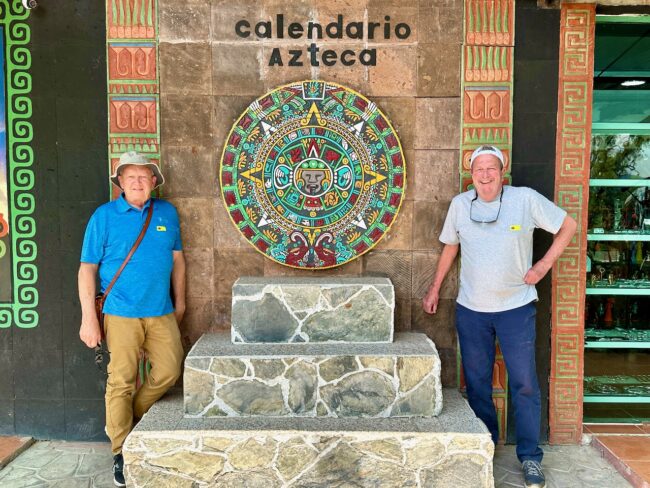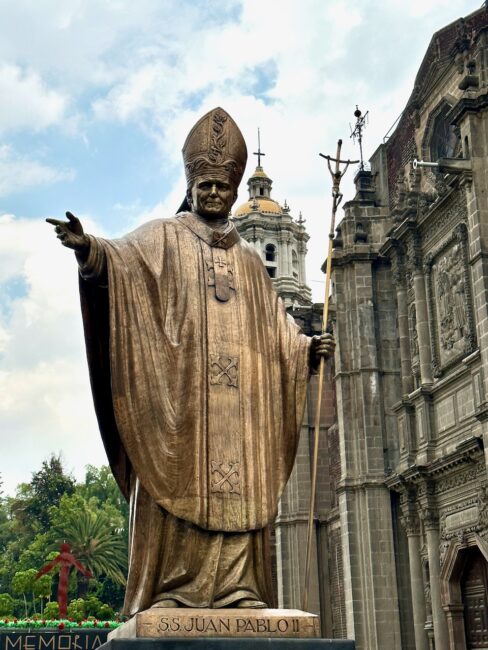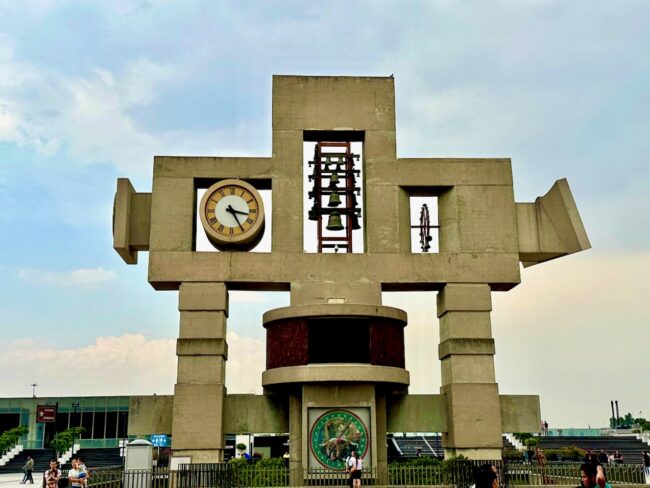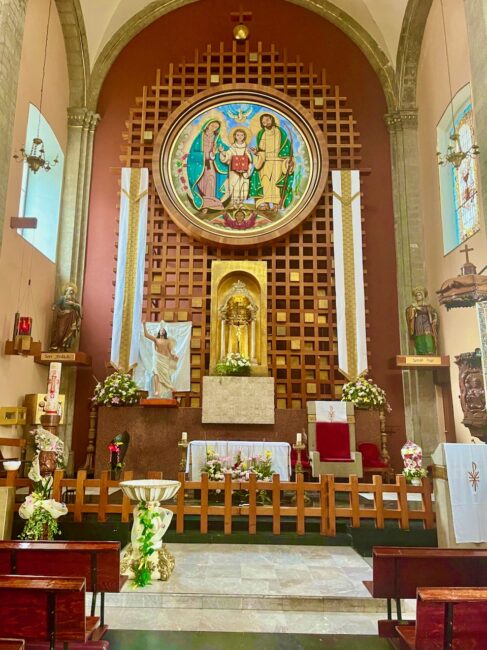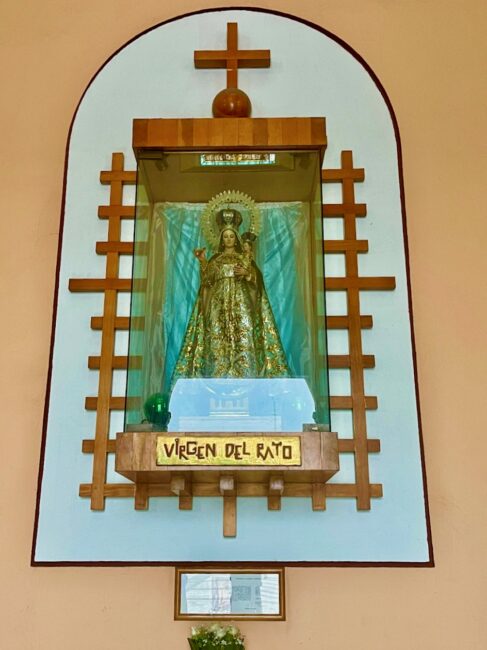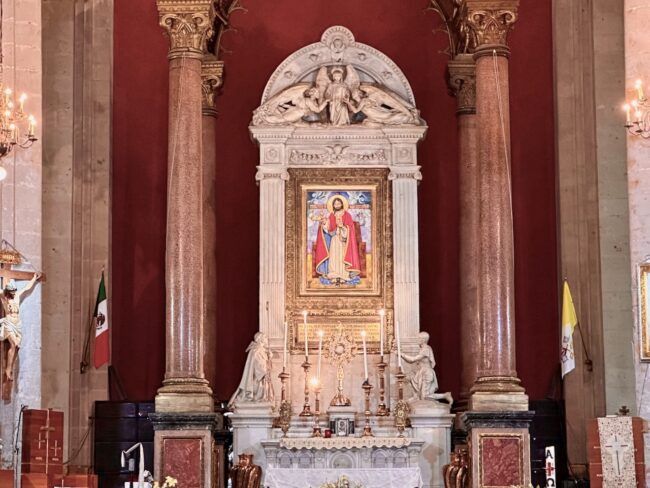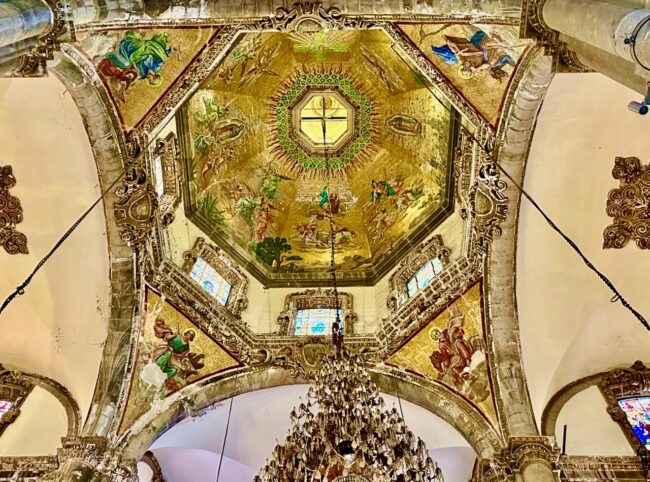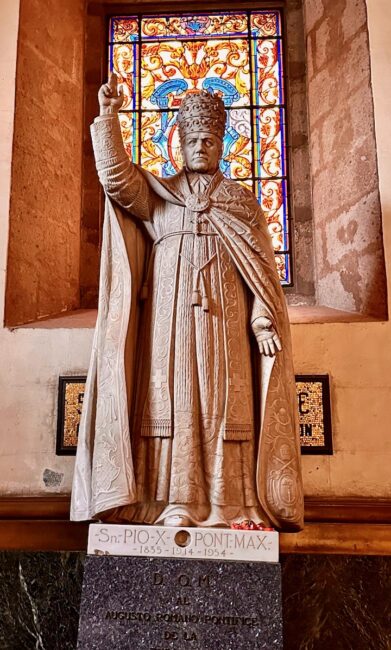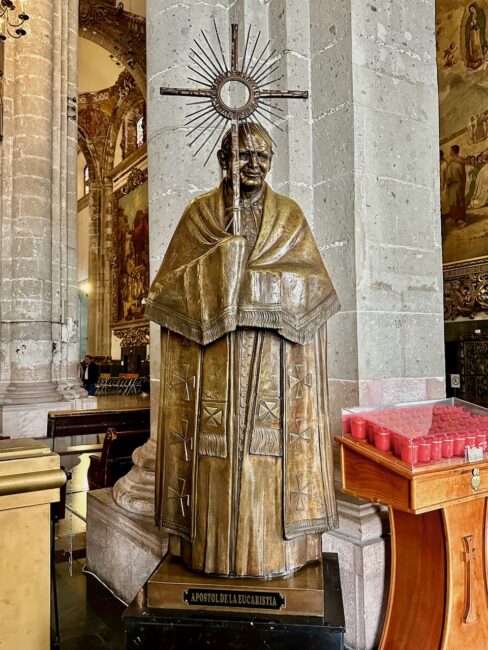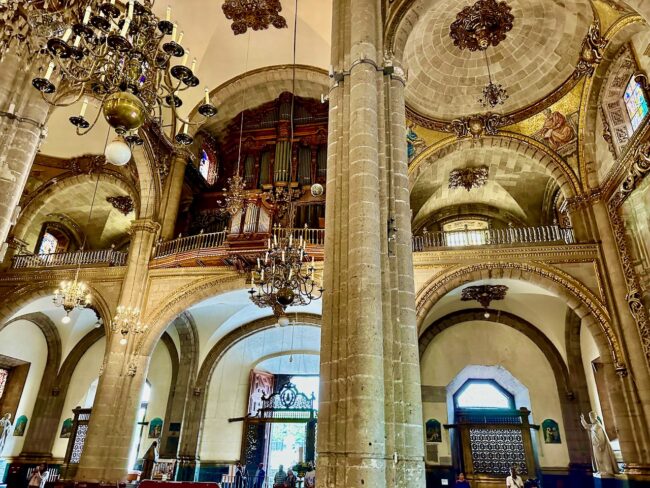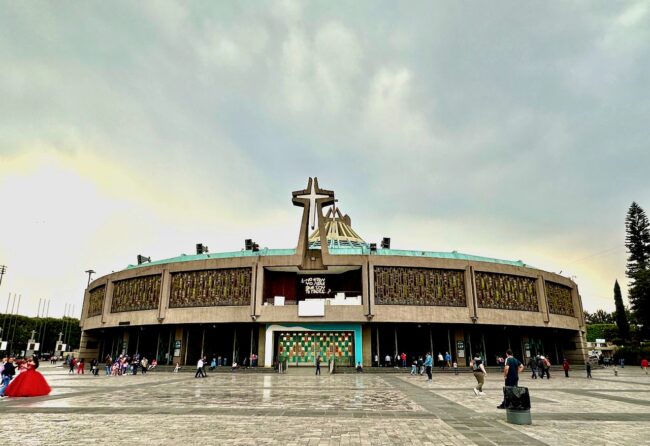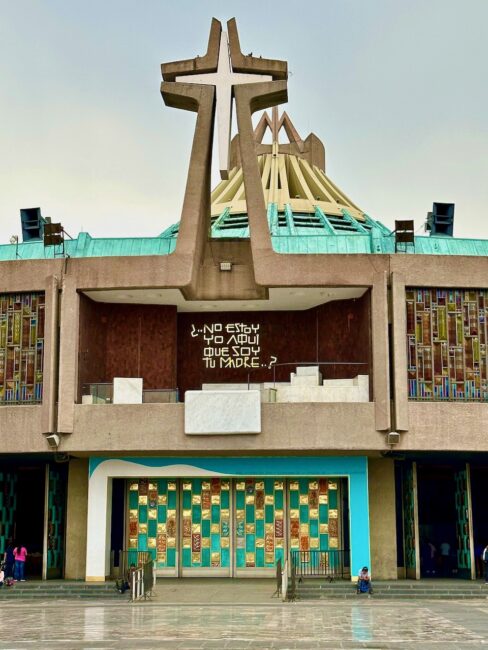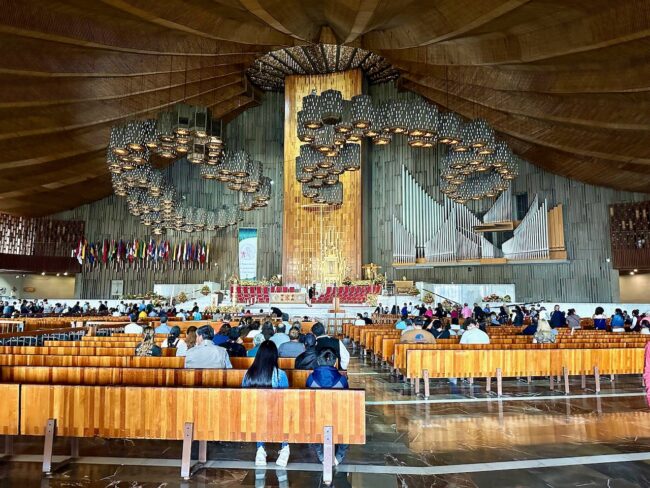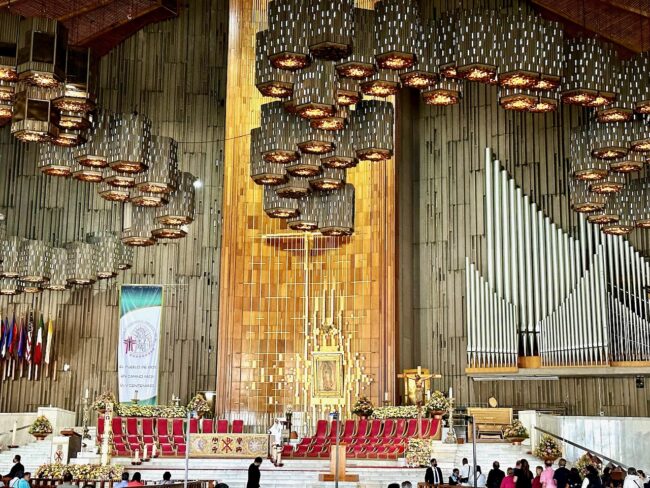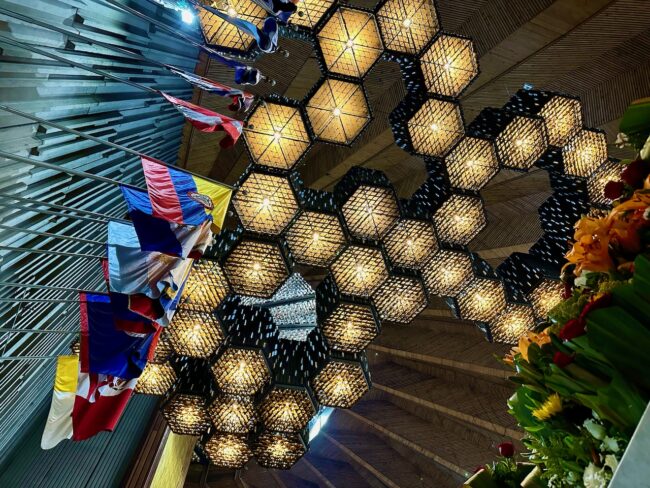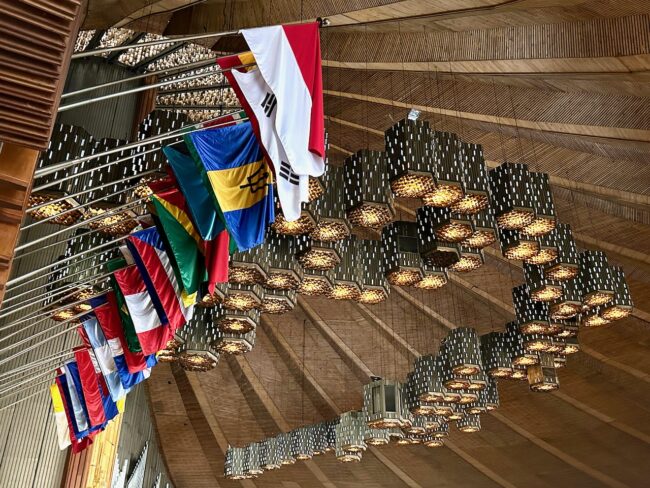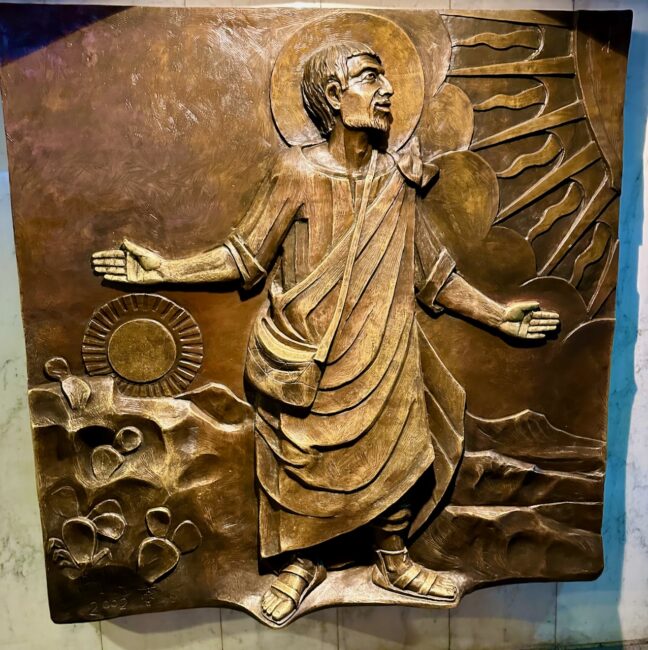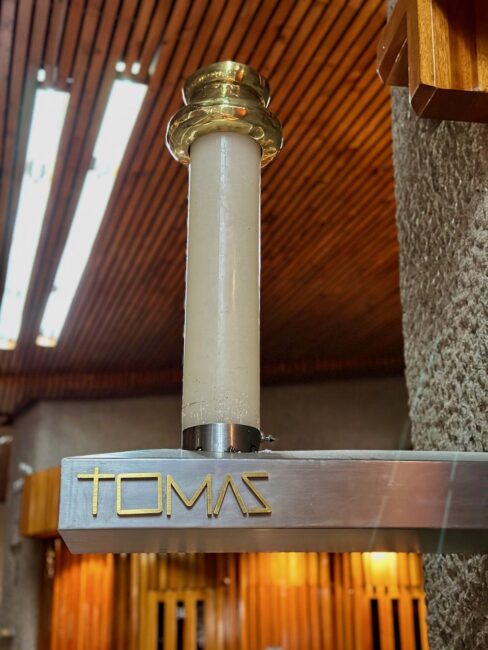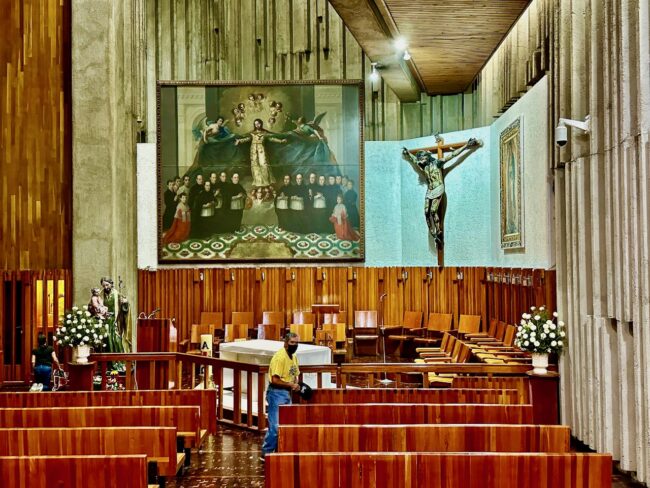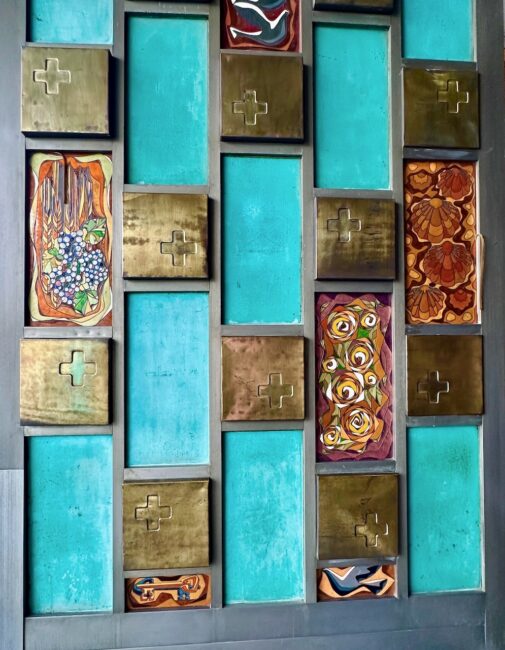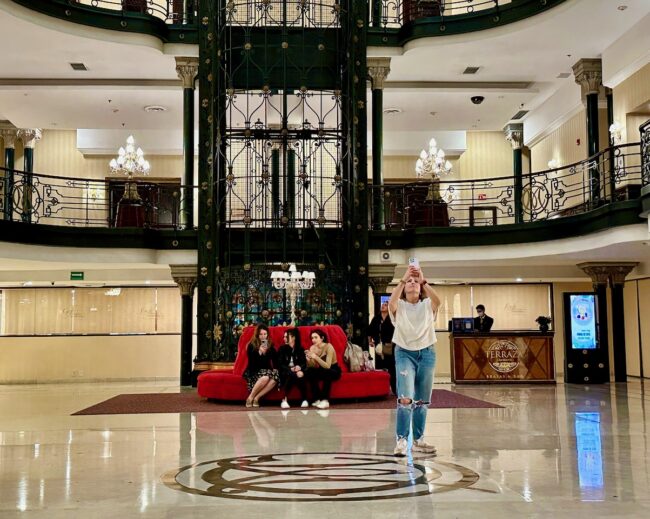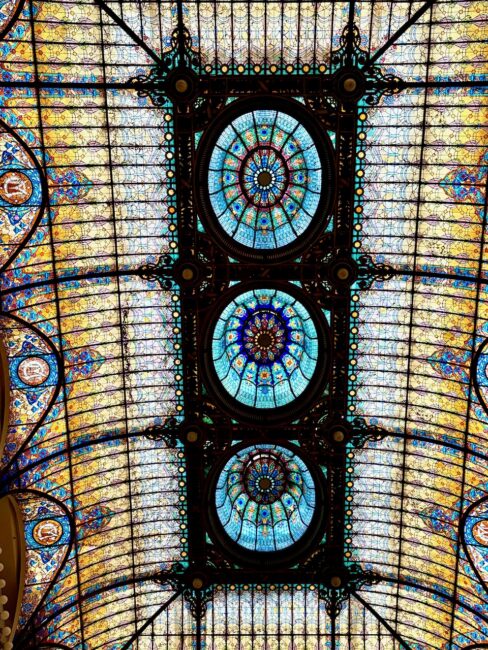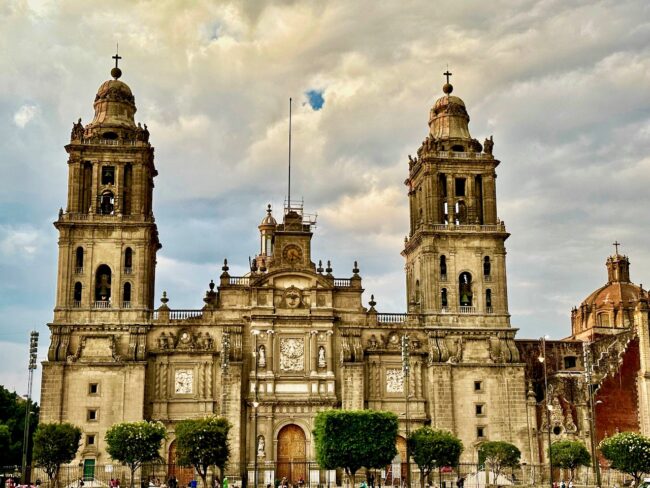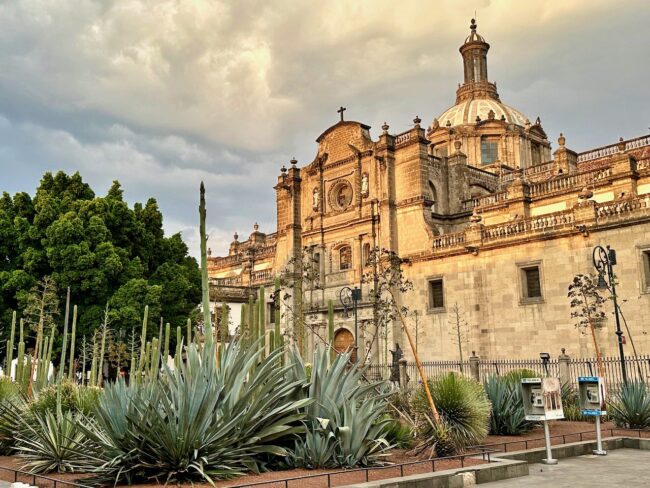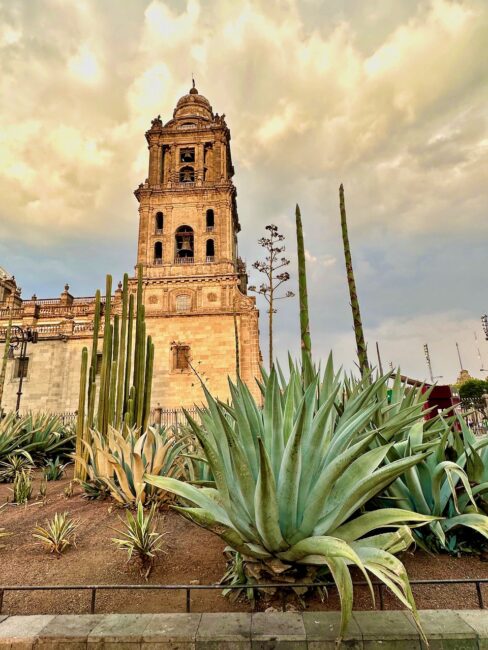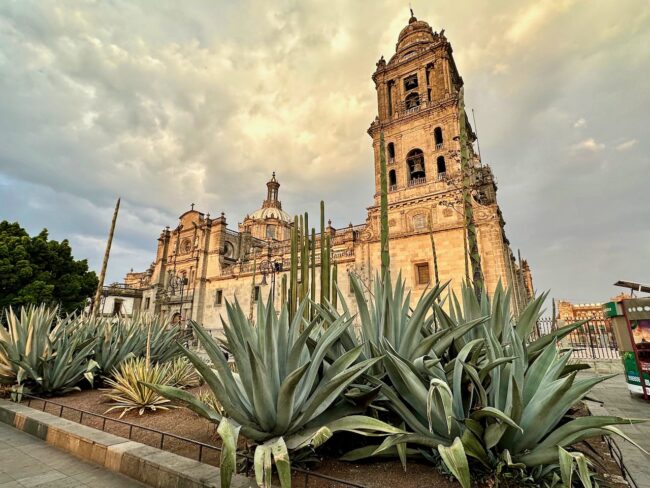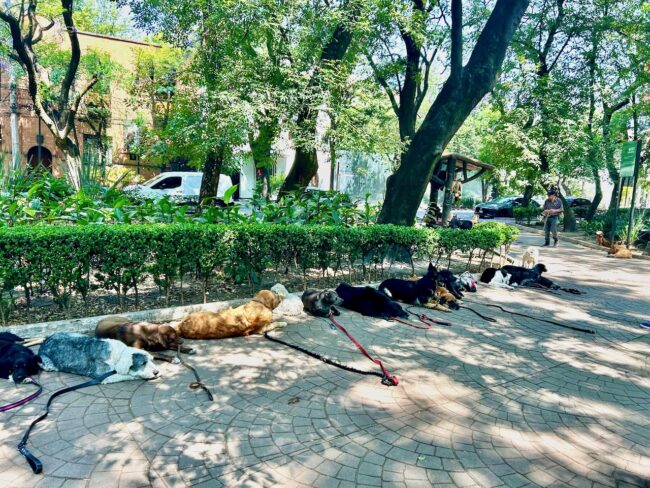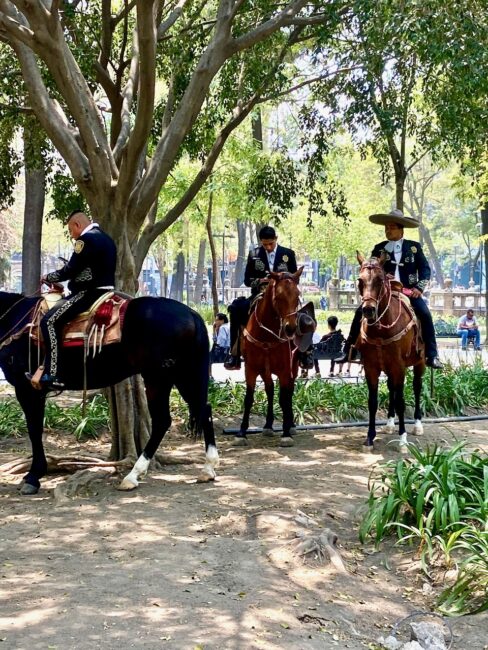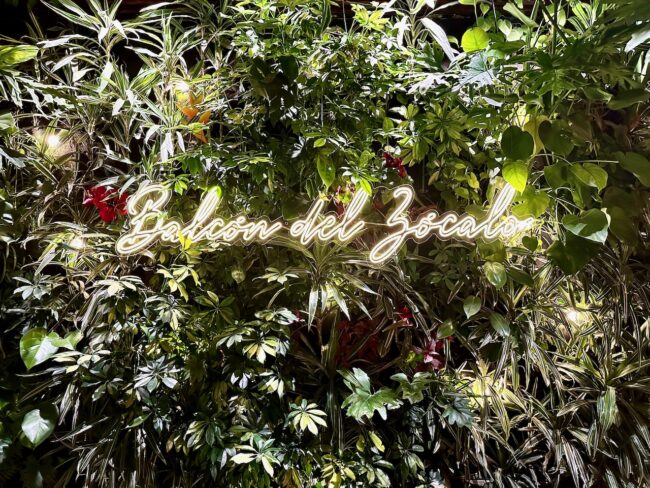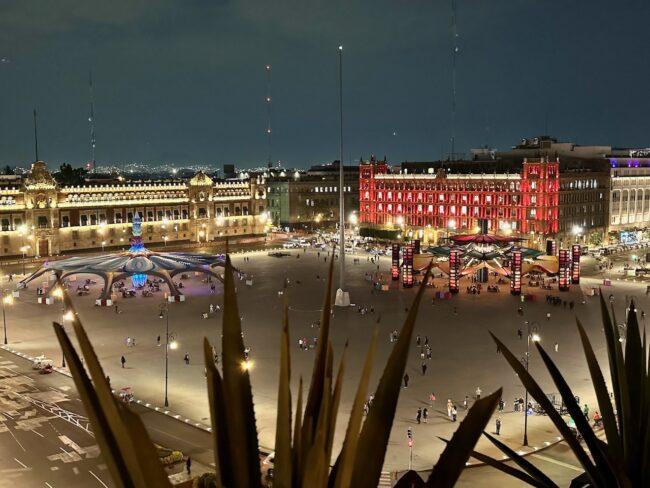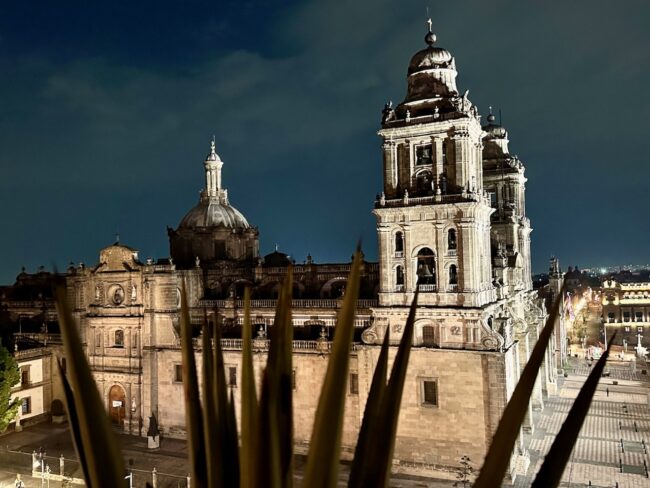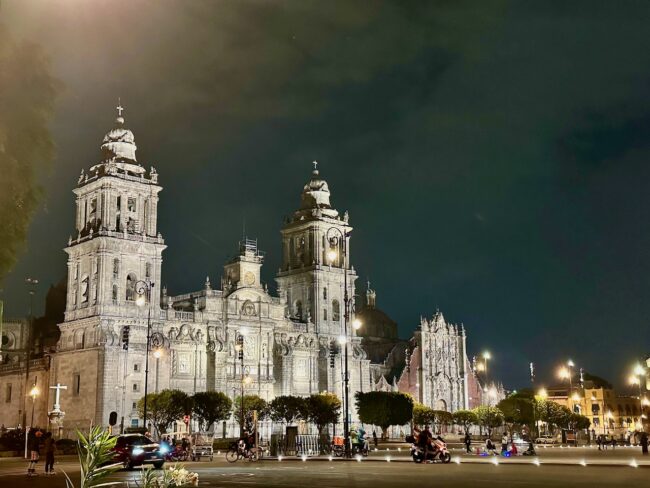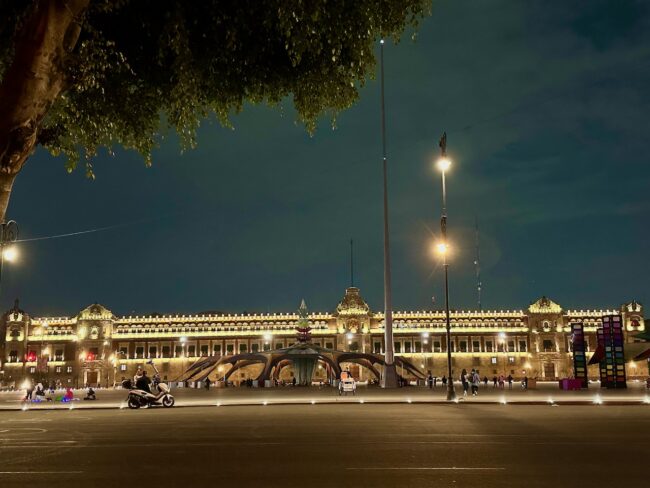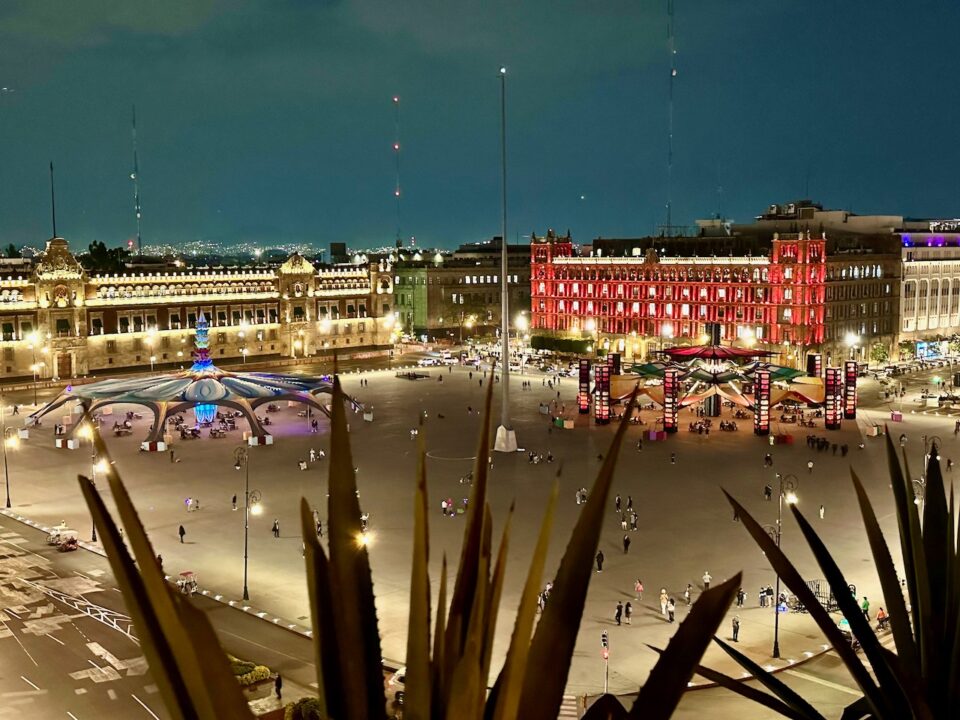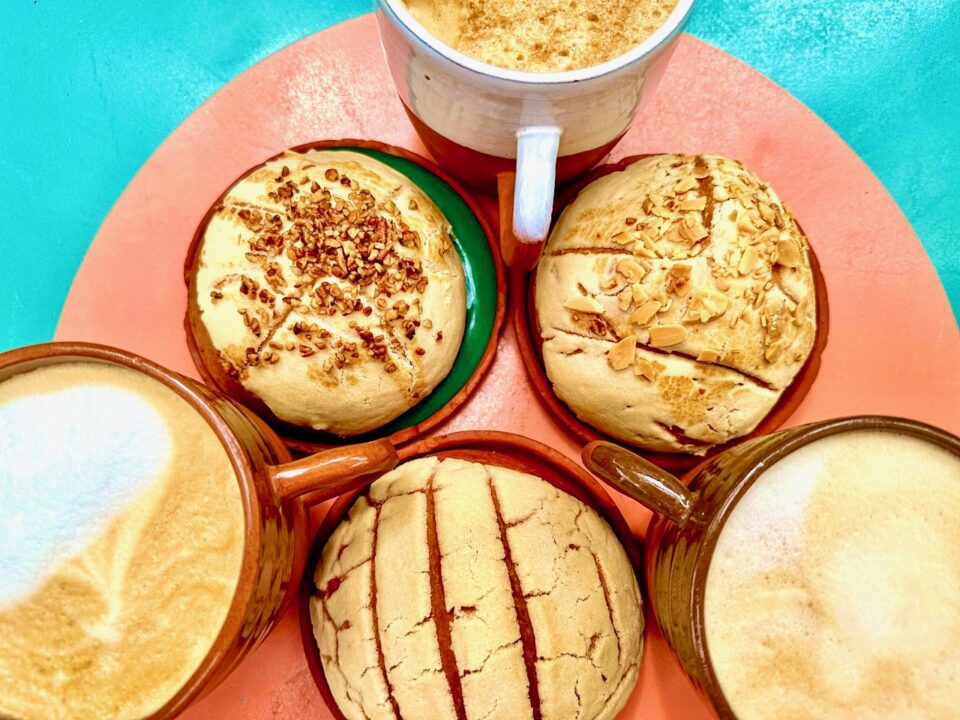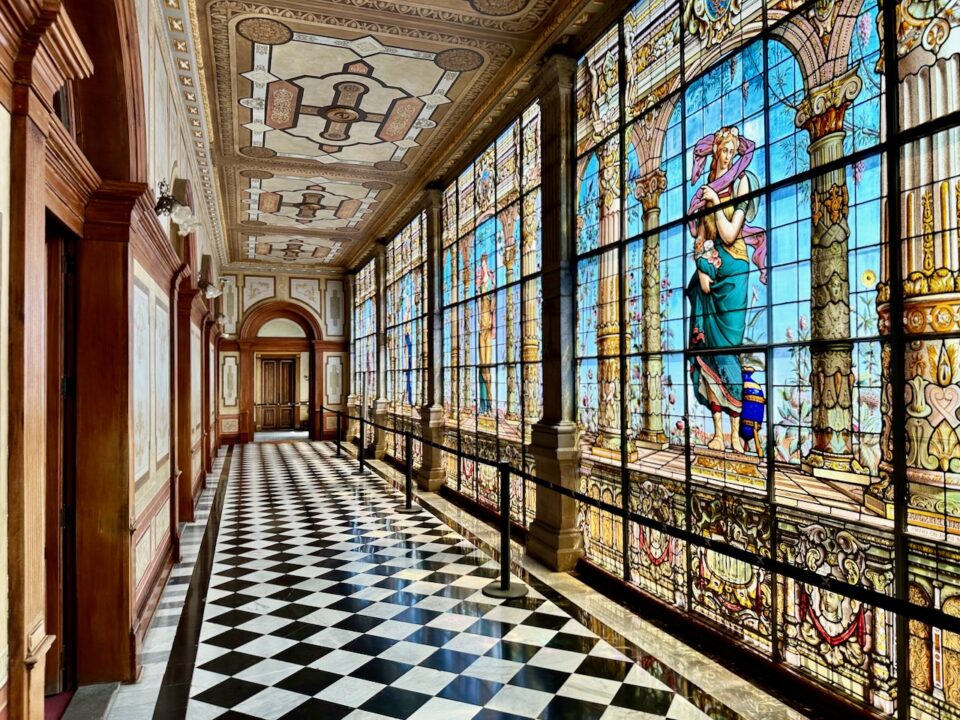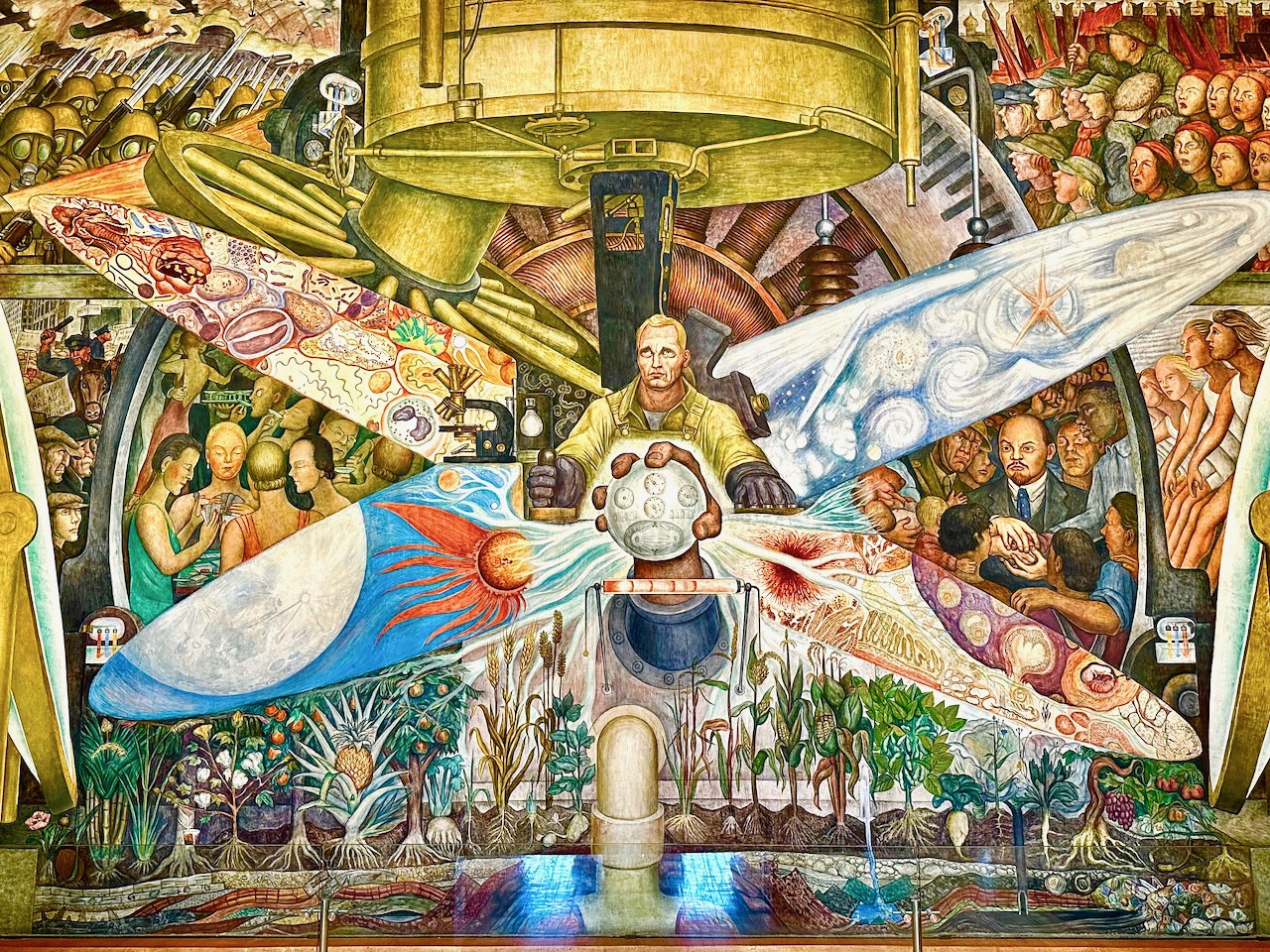
Chapter Three: Exploring Centro Histórico & Los Tres Grandes
May 31, 2023
Chapter Five: Diego Rivera Mural Day
June 21, 2023Historical & Hip: Mai Tai Tomás Travels To México City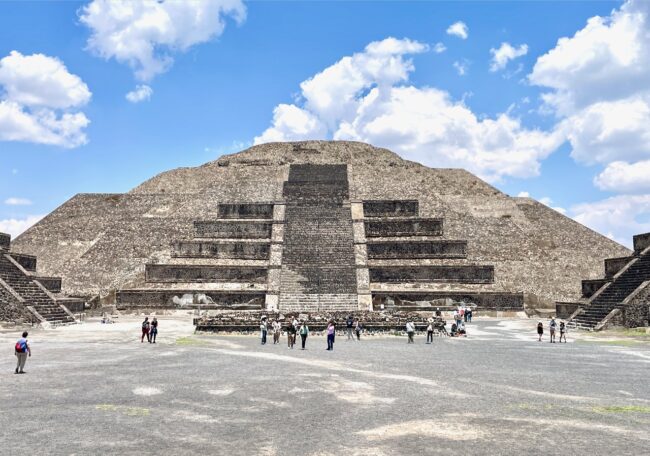
Chapter Four: Pyramid Scheme & The Miracle Cloak
Day Four: Heading To The Pyramids, Drinking & Shopping, There’s Always One, Over The Moon, Under The Mexican Sun, Red Lobster, Hat Trick, Let It Slide, Sacred Site, People Mover Shrine, “Ambiancing” Condesa, A Very Confused Bartender and Zócalo View Dining
Standing in front of the hotel at 9 am, Stephen, Tracy and I waited for a van. That’s because, before heading to Mexico City, I had booked a tour to Teotihuacan, the site of old pyramids (outside of the Luxor, I can’t think of any relative new ones), with the two most famous being the Pyramid of the Moon and The Pyramid of the Sun. Speaking of sun, in the directions emailed to me it said to be sure to bring a sun hat and sunscreen (foreshadowing alert).
We hopped in the van, which included four others on the tour, our driver (Carlos) and our guide (Rafael). Our first stop was less than 15 minutes from our hotel. Tlatelolco is an archaeological site dating back to the 1300s with a violent history. For a while it was an Aztec ceremonial center, until it was conquered by a dissident indigenous group (Tlatelolco) in the 1470s. They lived in relative peace until the Tlatelolco declared their independence, and the Aztecs invaded and regained total control. That is, until Cortés and the Spaniards came and much bloodshed ensued. There are temples and pyramids that have been excavated here In the background, the Church of Santiago Tlateloloco, which was constructed on the site of previous Aztec pyramids to “make sure to destroy the previous culture and reinforce the Spanish way of life” stands. Cortés forced Aztec survivors to help build the church.
Back in the van it was on to the pyramids, or so we thought. On the nearly hour-long journey, Rafael plied us with non-stop tidbits of Mexico City history along the way. We passed some colorful towns and aerial tramways that transported citizens. I was going to see if Carlos might stop so we could take a photo, but Tracy said the “check engine light” had been on since we started, so I just wanted to get to our destination.
The pyramids appeared in close proximity when the van made a turn into a parking area at Taller de Artesanias Finas el Sol, which, to my knowledge, was not the name of a pyramid.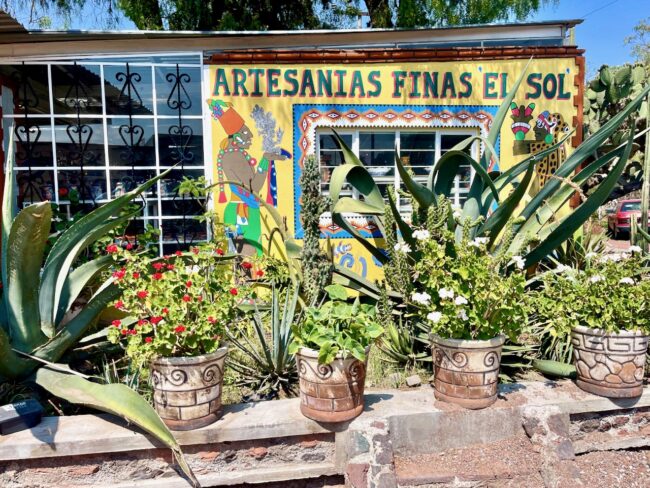
I had forgotten that often times on tours they stop at a place where they hope you will spend your money, and this fine crafts workshop was the place. The owner gave about a ten-minute talk on the shop, which would we find out is also a souvenir mecca.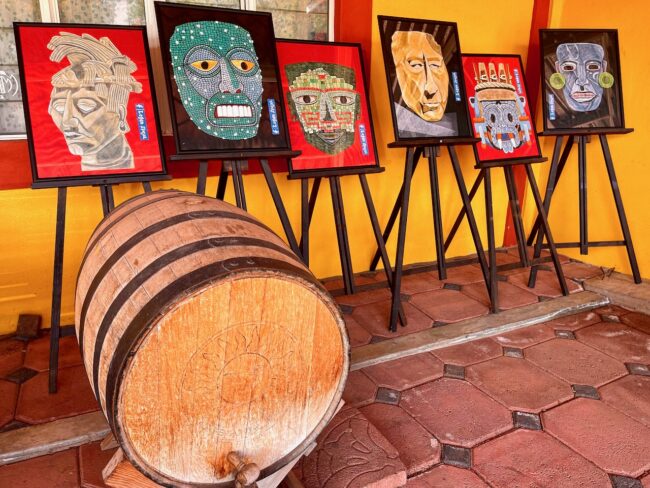
I had nearly tuned him out until he said the magic words, tequila and mezcal. The shop held a dizzying amount of handicrafts that I had to admit were interesting (no photos allowed inside). But first, Stephen and I took part in a tasting of mezcal and tequila liqueurs. “Well, it’s 11 a.m. somewhere,” I said. You’re not allowed to take photos inside the shop.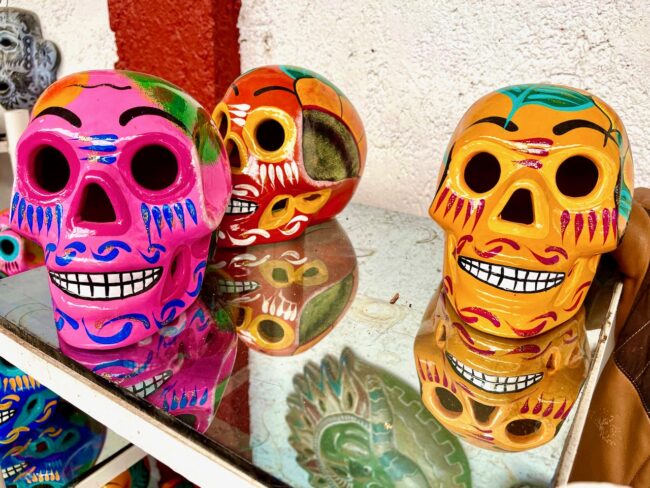
Meanwhile Tracy was nowhere to be found, so there was only one conclusion … we would not have as many pesos as we had before the tour. Sure enough, she exited with a colorful tablecloth that only cost US$50 (shown here at a recent barbecue we had at the house).
Not to be outdone, Stephen also bought a couple of souvenirs for his home. 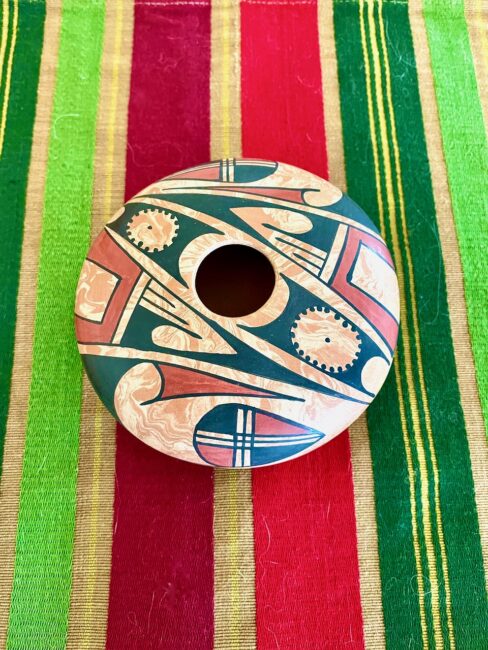
Ready to roll, the entire tour group boarded the bus … except for one. On virtually every tour I’ve ever been on, there is always one person who I would like to vote off the island. After about five minutes the guy’s friend went searching for him. Five minutes later he returned without his friend. “He’s still shopping.” Now, a more drastic punishment was in order. The guy finally exited the store with something and told his friend he was proud because he was finally able to haggle the price down on whatever he bought. Tracy gave me a warning look of, “If you say anything to him, I’ll rip your throat out.” Silence was golden.
It was a short hop to our destination. Teotihuacan (“the place where the gods were created”) dates back to the first century. 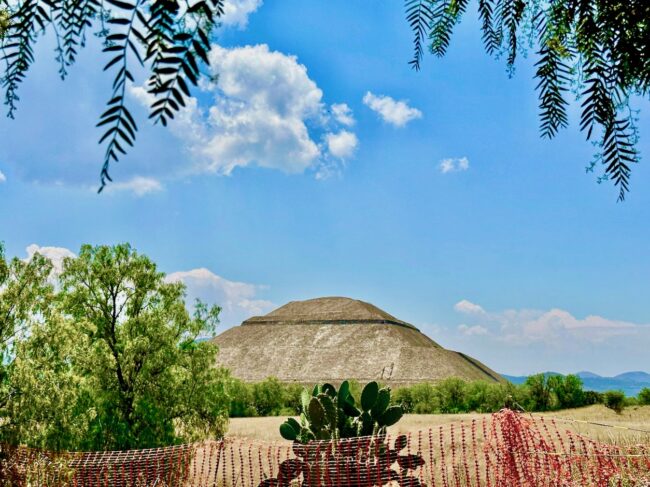
Over the next six centuries monuments were constructed, the two most famous being the aforementioned pyramids. Under the shade of a tree Rafael gave us the history of this magnificent site.
We set off on our own to explore, and it was about 15 minutes later I remembered I did not bring sunscreen nor a sun hat. Following directions has never been my strong suit. I knew that because my head suddenly started to feel like someone was breathing fire over it. I hoped I would not join this soul.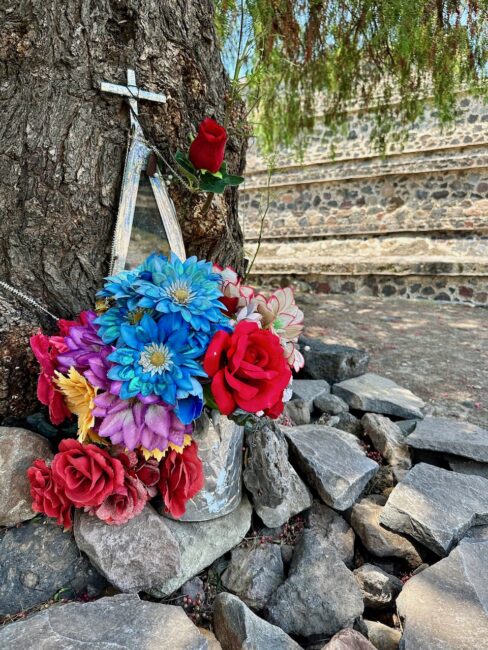
Carrying on, we walked over to the Pyramid of the Moon, which is the second largest of the pyramids.  Construction took place between the second and the fifth centuries. It is estimated that the population of Teotihuacan ranged between 150,000 to 250,000 people at its height.
Construction took place between the second and the fifth centuries. It is estimated that the population of Teotihuacan ranged between 150,000 to 250,000 people at its height.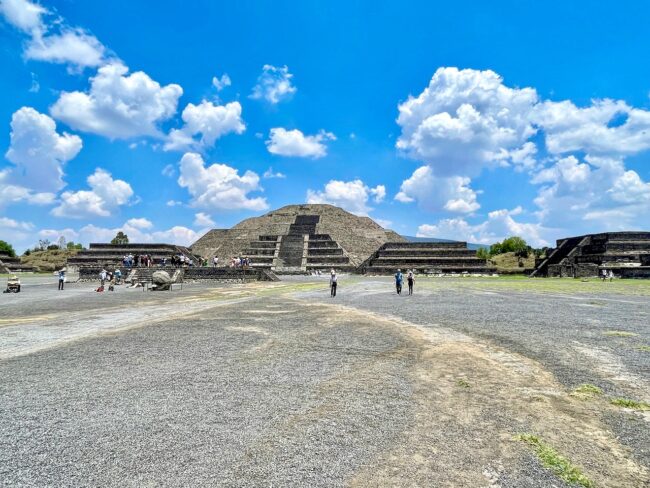
We took in the surrounding areas with Rafael sometimes gathering the group to impart more historical knowledge. He really did an excellent job throughout the day.
Rafael told us to not to climb the pyramid. He needn’t have worried.
We took in the pyramids from all angles.
My head was now on fire as I stared down the appropriately named Avenida de los Muertos, the primary path between the pyramids. It’s called the Avenue of the Dead because it is said the path was paved with tombs. Fortunately, the Avenue of the Dead now has live vendors, and for a small price I was able to buy a touristy Teotihuacan cap at a paltry price, which saved my head, but not my skin. Tracy said I looked like a red lobster, and not the restaurant.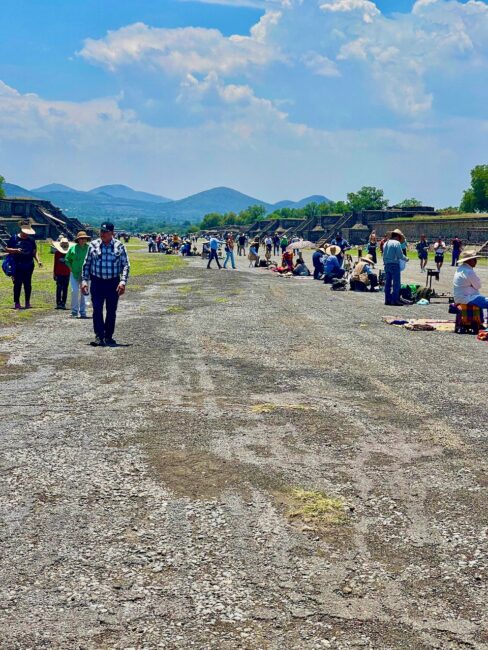
Heading down what I now called The Avenue of the Hat, we ducked into see some murals, and also listen to more history of the area. It was very interesting, but I think I’ve hit the traveling stage of life where I have joined joined Tracy in the club of “I don’t think we have to visit a lot of ruins anymore.”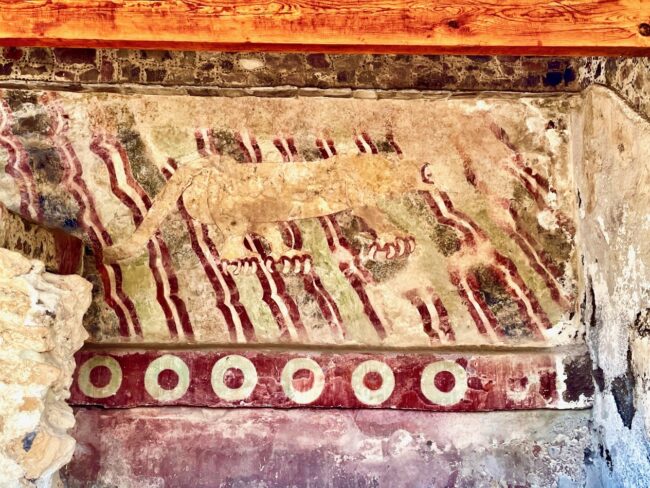
Near the end of our Teotihuacan tour, we ventured toward the Pyramid of the Sun. The Pyramid of the Sun was named by the Aztecs after the city had been abandoned. It was built in the third century and is more than 700 feet tall. As of April of 2023, you were not allowed to climb on either of the two large pyramids. I thought I was safe.
In front of the Pyramid of the Sun is a structure that you climb, which Rafael said afforded a great viewing opportunity of the pyramid. I was about ready to tell Tracy and Stephen to capture some photos, when Rafael gave us the bad news that we would all need to descend on the other side in order to walk back to the van. Visions of the Lisbon emergency room danced in my head (see details here).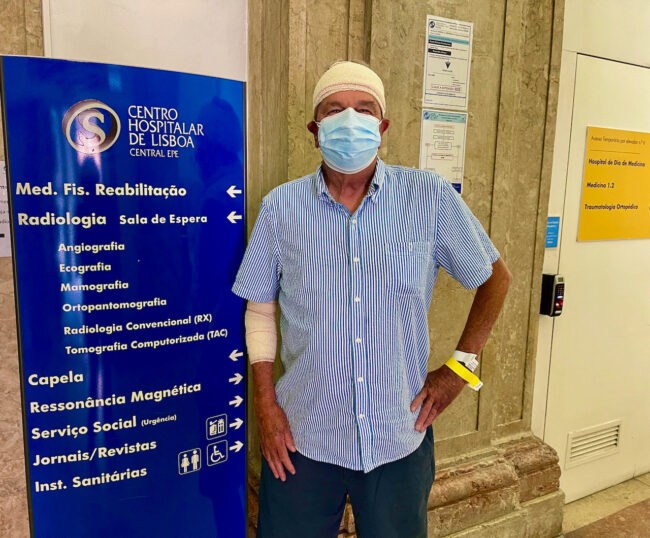
I carefully climbed up the very narrow, uneven and steep steps with nary a hand rail in sight, grabbing ahold of Tracy’s shoulder as to not plummet to my certain death, although it might have been a good story to have it all end on the Avenue of the Dead. At the top we all took a couple of photos, and now came the “going down” part, which I hoped would not have a literal aspect to it.
Holding onto Tracy’s shoulder, I took one uneasy step down and realized this was not going to happen. Short of ordering in a helicopter to airlift me out, I needed to formulate a descending plan. There really was only one option, one that would forever live in ignominy. Sitting down on my butt, I carefully slid down step after step (about 30 of them I believe) looking like a human Slinky (although a Slinky is more graceful), hoping there were no camera phone videos rolling. I navigated the steps without incident except for a rather dirty seat of my pants.At least we did get the good view that was promised. I wish I had taken a photo of the steps, but at this moment I was just happy I made it down.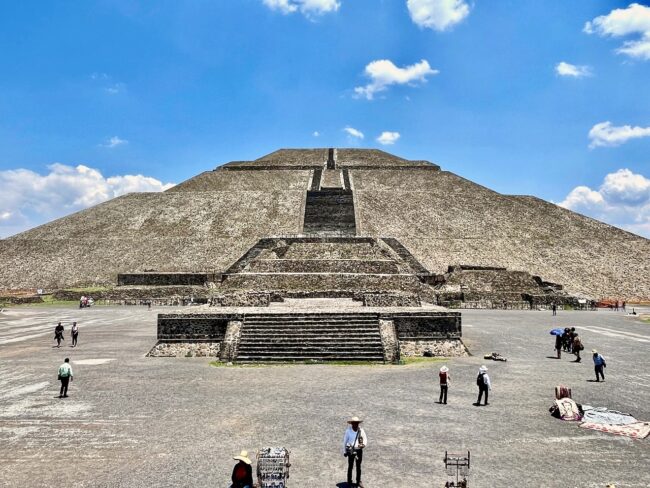
My dignity now in shambles, I arose, dusted my rear end and walked back toward the van pretending that didn’t just happen. Stephen was bemoaning the fact he didn’t take a video, which would have made for some good dinner fodder. 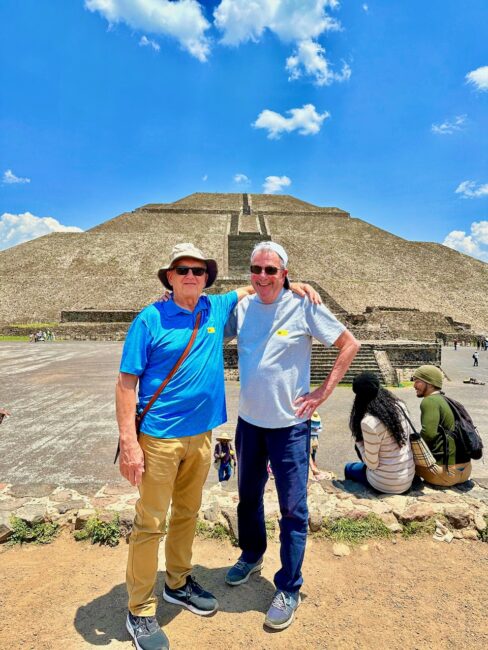
Gazing up at the Pyramid of the Sun, I asked Rafael who the person was on the steps of the pyramid. “He’s guarding against anyone trying to climb up.” I had hoped he hadn’t seen my recent climbing performance.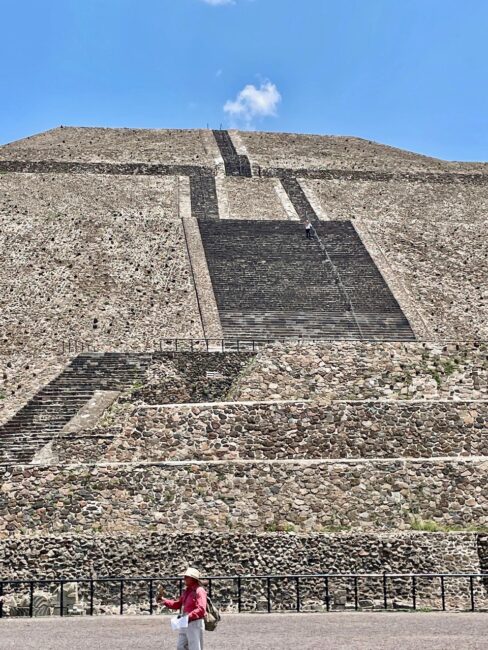
It was time to say adios to the pyramids.
Next stop on the tour was lunch. Although the restaurant had “tourist” written on it, the food was very good.
… and a fake Aztec Calendar.
Our final stop on the tour was the Nacional Basílica de Santa María de Guadalupe, one of the most visited religious sites in the world, and the second most visited shrine to the Virgin Mary.
From various sources here’s one version of its founding. In December 1531 an Aztec Indian (some say he was an Aztec prince) named Juan Diego was walking on Tepeyac Hill when he saw a bright light and a vision of a girl (the Virgin Mary … or in Mexico, Our Lady of Guadalupe). She told him to seek out the local bishop and tell him that the Virgin Mary wanted a church built in her honor on the hill. Diego tried to convince the local archbishop of his story several times, however the bishop didn’t believe Diego’s story and said he needed further proof, Rivera saw the apparition again, and she told him to gather roses (this was not rose season) and take them to the bishop as a sign. Although it was winter, Rivera found some roses and put them in his tilma (cloak). When he saw the bishop, dozens of roses fell out and an image of Mary imprinted on the inside of his cloak suddenly appeared. Construction of a church started. The Old Basilica (below) was finished in 1709. It was the first to display the tilma with the image of Our Lady of Guadalupe.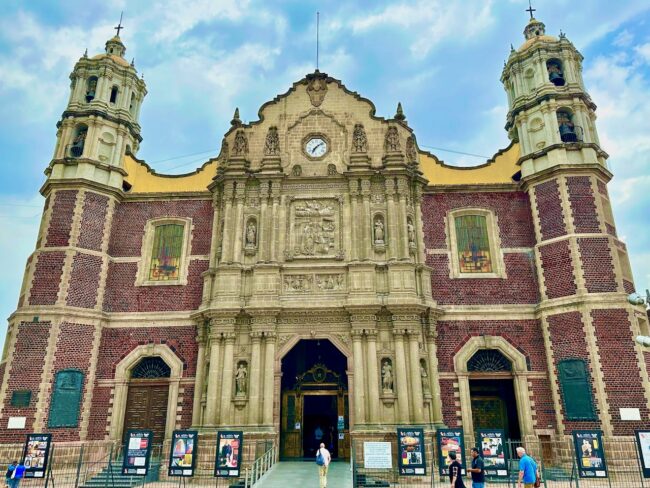
While the others went to the Old Basilica, I stopped in a little side chapel for a moment.
The Old Basilica is where the tilma with the image of Our Lady of Guadalupe was originally displayed.
In 1921, a terrorist bomb destroyed much of the church, yet the cloak survived unscathed.
As we had learned from our guide, much of Mexico City was constructed on a dried lakebed. Because of this, the church began sinking, so a new basilica was built in the 1970s. The Old Basilica was closed for a number of years.
From the outside, the Modern Basilica takes the shape of a basketball arena and it can seat just as many people as many arenas.
The complex holds up to 10,000 people.
Tracy was enamored with the light fixtures.
Now it was time to check out the miracle cloak. A moving people-mover like the ones they have in airports whisks you by the cloak, protected by bullet-proof glass. There was no one in line when we sped by and Tracy got a couple of photos.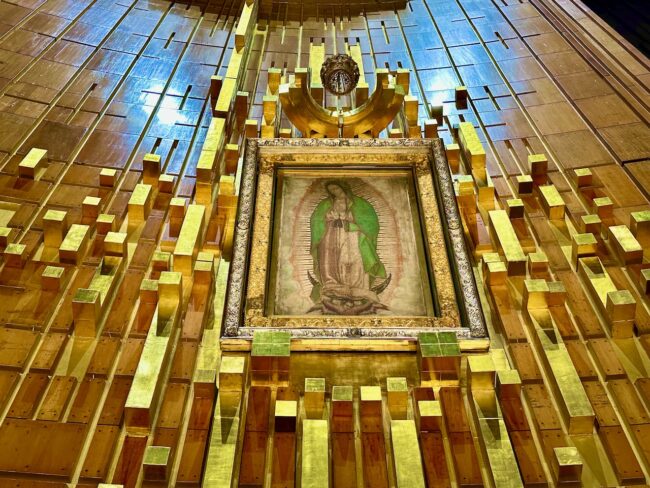
About five minutes later, the moving sidewalk had so many people that it looked like the crowd at a Taylor Swift concert.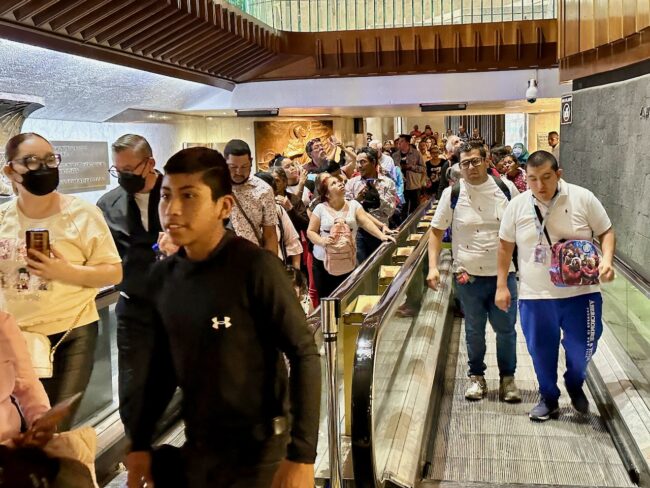
One fact has perplexed scientists. “After nearly 500 years, the tilma bearing the image of Our Lady of Guadalupe is still perfectly preserved, when it should have decayed.” They say the material should have decayed in a short number of years after going on display.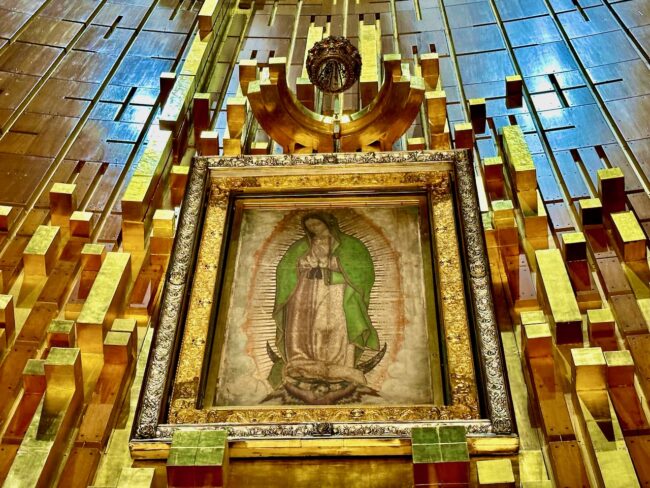
Unfortunately it was already time to return to the van …
… so we didn’t get to see everything I had wanted.
Our tour was good, and our guide very informative. However, I think for future tours we might hire a private guide and go at a pace (and places) that fit our needs a little better. This way, I never have to wait for “Mr. I need to get the price down guy” again.
Back at our hotel, just like every time we entered the lobby, someone was taking a photo of that magnificent ceiling. This might be the first time I’ve ever stayed at a hotel that was also a tourist attraction.
For dinner on this evening we would dine at the hotel where Tim and Sheila were staying, El Bálcon del Zocalo at the Zócalo Central Hotel. Not surprisingly we walked past the Zócalo to get there.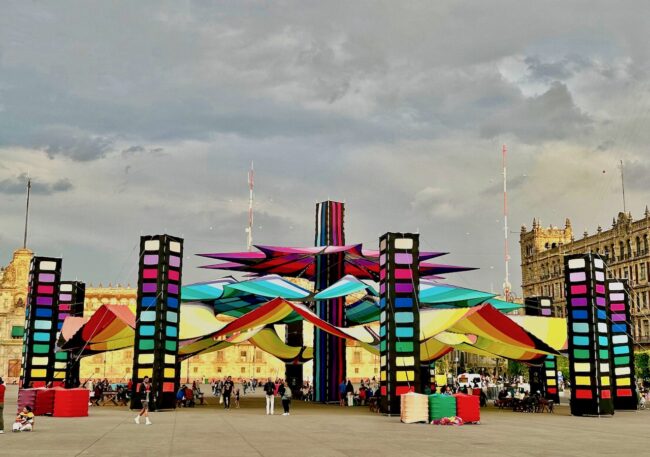
Walking by the Metropolitan Cathedral, the light was just turning, which gave it some beautiful color.
The cactus garden in front of the cathedral looked pretty cool at this hour.
I thought about stopping here for a quick taco appetizer on the way to dinner. It smelled wonderful.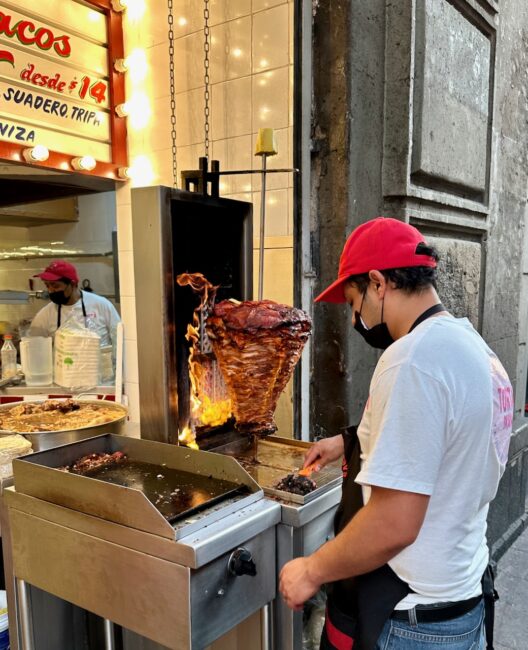
Tim had texted to meet at Pata Negra Centro Histórico, a bar near to his hotel, for a pre-game cocktail (or two). It was a good-looking bar lined with books and booze, always a good combination.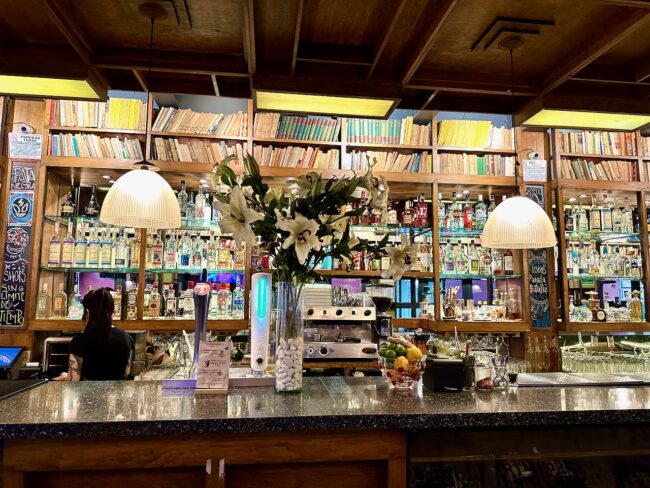
The bar had an extensive list of gins to choose from, so while the rest of us ordered wine, Tim and Stephen decided upon a gin and tonic. Our personable server seemed perplexed with the order, but took it and went to the bar. Soon Sheila, Tracy and I were sipping our wine, however the gin and tonics were nowhere to be found. The server came back again and again, while Tim attempted to explain what they wanted, which seemed strange because with all its gins, you’d think gin and tonics must have been ordered here before. Finally, after a number of server trips to our table, the bartender came to the rescue and soon Tim and Stephen were drinking their gin and tonics, which gave the rest of us the opportunity to enjoy a second glass of wine.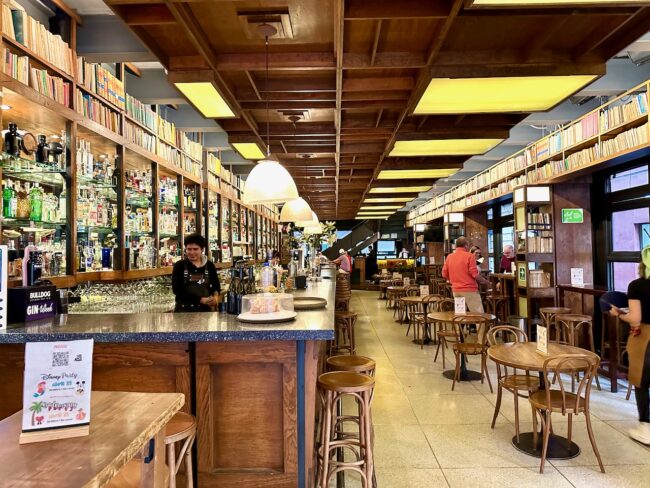
I asked Tim and Sheila what they had done that day, and Tim said they had walked around Condesa and Roma Norte. “Did you see anything of interest,” I asked? Tim answered yes, and added, “We really just spent the day ambiancing in different neighborhoods.” “Ambiancing” was a word I had never heard. That’s because Tim and Sheila had made it up, and it sounded great.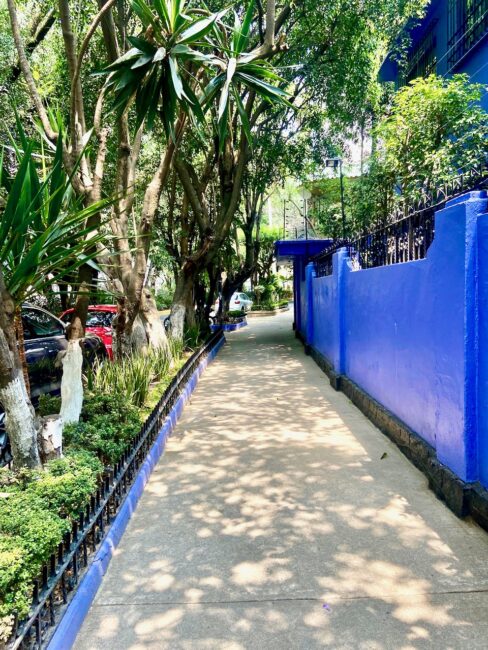
I asked them, “What does ambiancing exactly mean?” He gave a quite eloquent description, however I was on a second glass of wine as was my scribe (aka Tracy), so we asked if he’d send us something in writing when he got home. Here is his description of a word that will soon be used by travelers throughout the world. ”Ambiancing is easier to do than define. Any attempt sounds pretentious, which is antithetical to the concept. It’s the desire to catch a city’s vibe from street level. Visit city parks and watch children play on the swings, parents supervising, while having a glass of wine. Going to a great and celebrated well-known spot with the crowds is noteworthy; finding an off the beaten path locale is a memory. It involves few must-sees and even fewer set plays. It accepts that sights will be missed and forgotten, but the feeling of the place will last.” 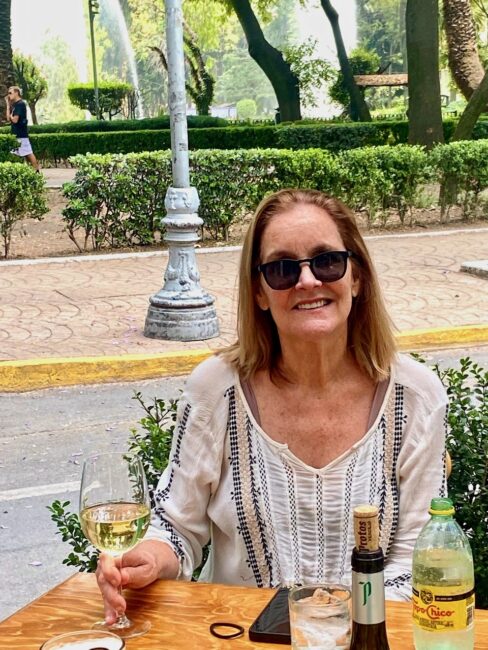
I’m not sure if sliding down some steps on your butt at some pyramids is ambiancing, but it is now.
In Condesa, Tim and Sheila witnessed another pack of those obedient dogs and something you don’t see every day, mariachis on horseback.
Plus they enjoyed both a relaxing breakfast and lunch.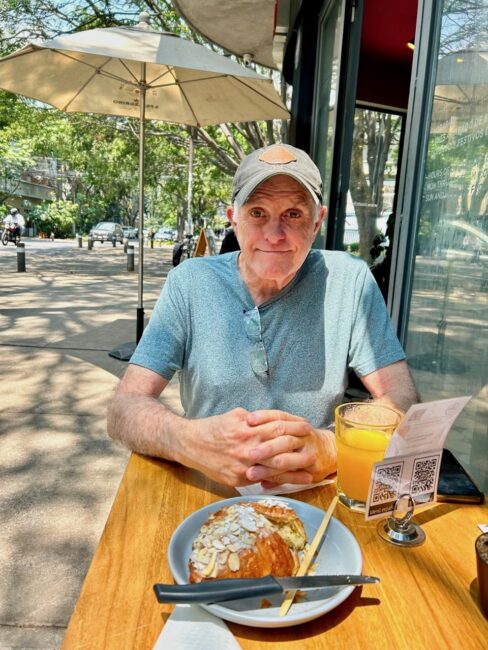
And now it was time for dinner. The interior and patio of El Bálcon del Zocalo is quite lovely.
It also afforded us some scenic views (as you can tell, we all like rooftops).
Looking at my sunburned skin while Tim and I perused the menu Tracy quipped, “Perhaps you should try the lobster.” It didn’t help my look that she had lent me a pair of cheaters that, like a Greek statue, was missing an arm. There are times I should not be allowed in public.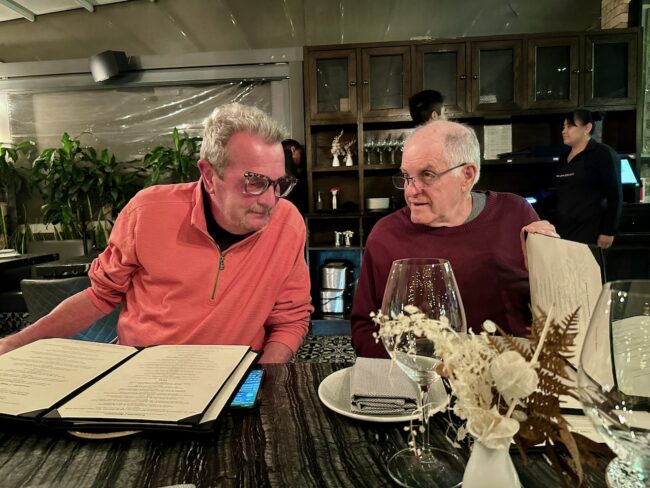
As great as the views were, so was the food. Stephen and Tracy enjoyed an avocado risotto with Oscosingo Cheese and grilled shrimp that looked mouth-watering, and they said it was terrific.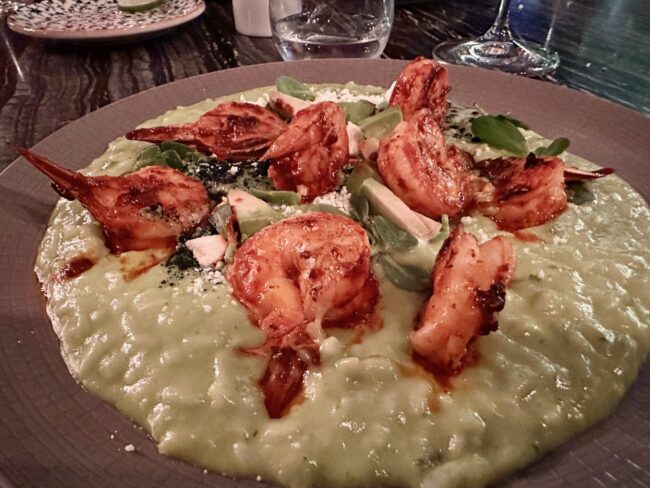
Tim opted for breaded mushrooms and Huauzonples, Oaxaca Cheese with poblano sauce.
Sheila went for the lettuce tacos with breaded shrimp in Coconut and Pipián with saffron.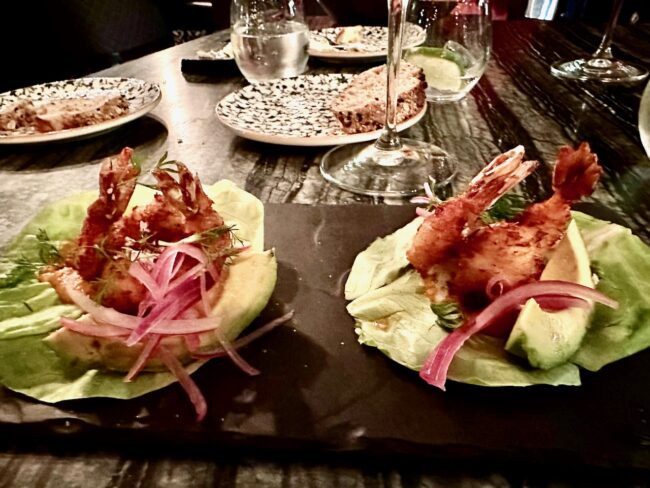
Because mole is my middle name, I tried the beef ravioli in Mole de Olla with garden vegetables.
Dinner was fantastic and afterward we, along with others out on a gorgeous Mexico City evening, did our own version of “ambiancing” with the The Torre Latinoamericana building in the background.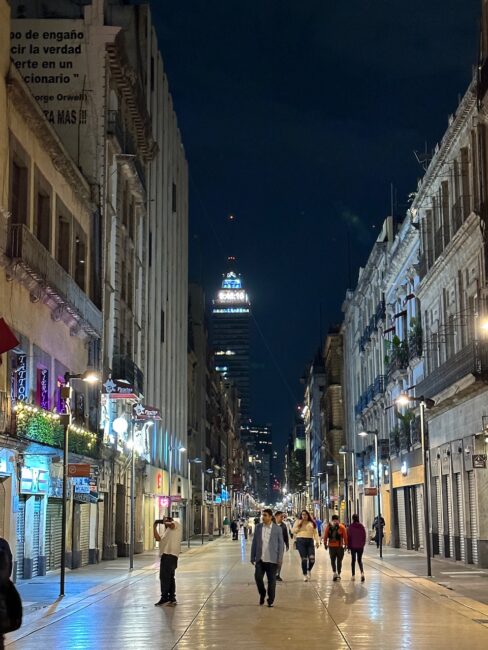
One last look at the cathedral and the Palacio Nacional, and it was off to bed.
Tomorrow would be “Diego Rivera Day” in Centro Histórico. We’d start with a tour of Palacio Nacional and his famed second floor murals depicting the history of Mexico (Spoiler alert … the tour was incredible.) Then it was off to the Secretaría de Educación Pública, where Rivera’s murals are also the star. Lunch included a view overlooking the Aztec ruins in Templo Mayor, and Sheila gave us a momentary scare by something she said.
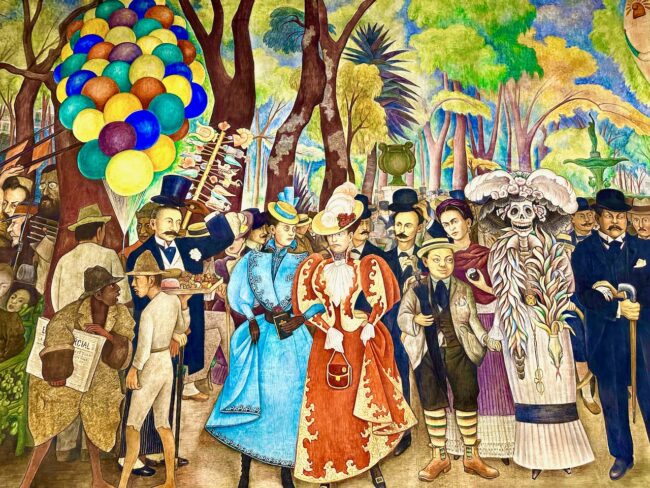 Afterward, while Sheila and Tim hit the Palacio de Bellas Artes and Stephen walked to the Museo del Tequila y el Mezcal, Tracy and I strolled through Alameda Central to the Diego Rivera Mural Museum to see his spectacularly colorful Dream of a Sunday Afternoon in the Alameda Central mural. It was at this museum where something happened with Tracy that made her happy, yet a bit sad.
Afterward, while Sheila and Tim hit the Palacio de Bellas Artes and Stephen walked to the Museo del Tequila y el Mezcal, Tracy and I strolled through Alameda Central to the Diego Rivera Mural Museum to see his spectacularly colorful Dream of a Sunday Afternoon in the Alameda Central mural. It was at this museum where something happened with Tracy that made her happy, yet a bit sad.
We’d end the afternoon at a bar where Pancho Villa supposedly put a bullet in the ceiling and then enjoyed (well, we enjoyed, not Pancho Villa) one last rooftop dinner. Mexico City was rapidly moving up the charts as one of our favorite places to visit.
Next: Chapter Five: Diego Rivera Mural Day
Day Five: Passports Please, No Dark Glasses, The History of Mexico in One Hour, Getting Some Rivera Public Education, More Ruins At Lunch, What Piece Of Paper?, A Walk In The Park, Who Are These People, Give Me A Shot and Our Last Rooftop Restaurant

